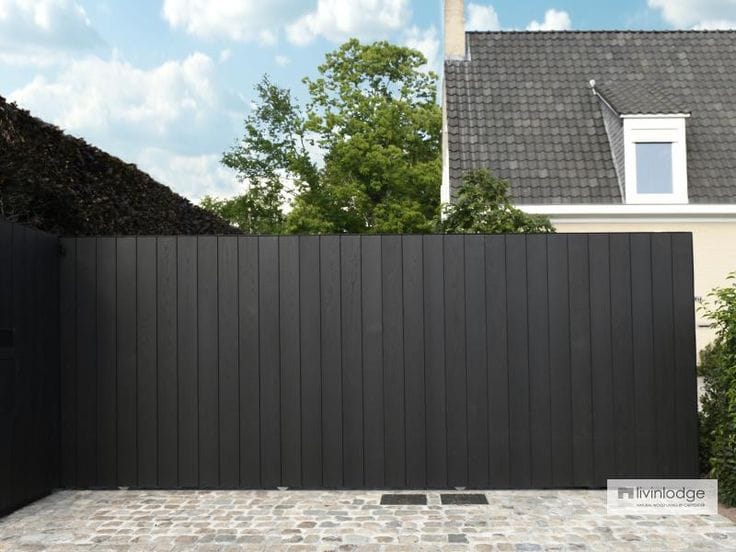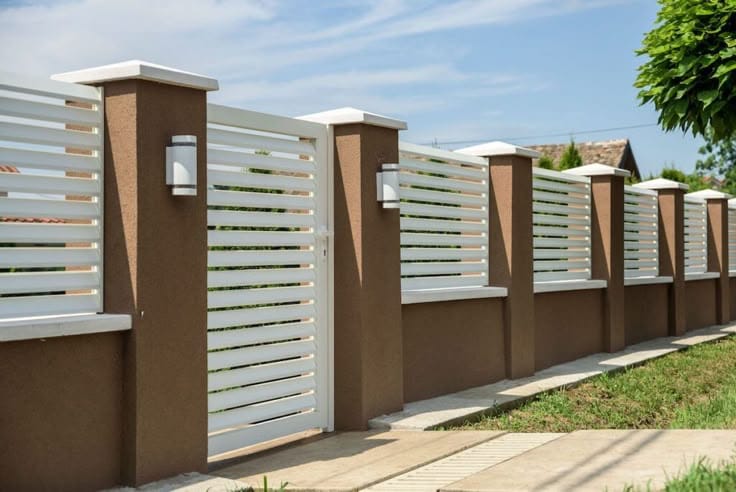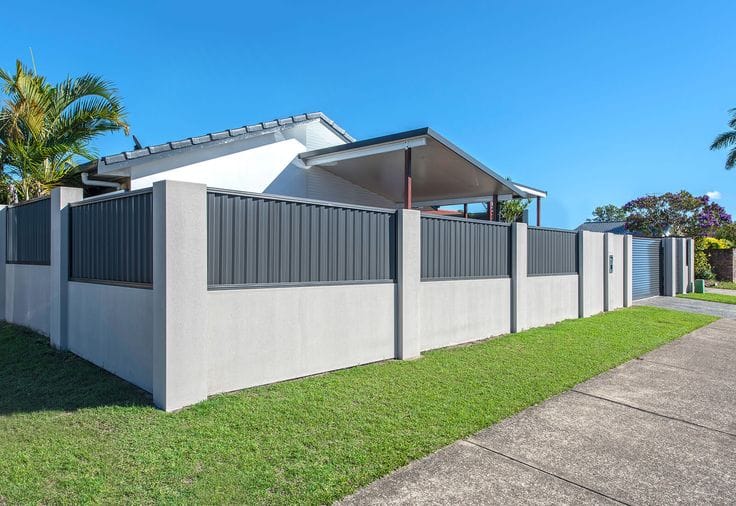
The Science of Fence Paint: What Makes It Durable and Weather-Resistant
Choosing the right fence paint can significantly impact the longevity and appearance of a wooden fence. Exposure to harsh weather conditions, UV rays, moisture, and temperature fluctuations can quickly deteriorate the paint, leading to peeling, cracking, and discoloration. Understanding the science behind durable and weather-resistant fence painting helps homeowners and business owners make informed decisions when protecting their outdoor spaces in Westport, CT.
Here are the key components of high-quality fence paint, how it withstands different environmental challenges, and best practices for ensuring long-lasting results.
Table of Contents
Key Takeaways✔ UV-resistant pigments protect fences from fading and breakdown caused by prolonged sun exposure, ensuring long-term durability. ✔ Waterproof paint formulations repel moisture, reducing the risk of wood swelling, mold growth, and structural damage. ✔ Paint with flexible polymers adapts to wood expansion and contraction, preventing cracks, peeling, and premature wear. ✔ Anti-fungal additives prevent mold, mildew, and rot, which are critical for fences in humid or rainy environments. |
What Are the Key Components of Fence Paint?
The effectiveness of fence painting depends largely on the composition of the paint itself. A well-formulated paint not only enhances the fence’s appearance but also provides long-term protection against weathering, moisture, and UV exposure. Each component in the paint formula plays a critical role in ensuring durability, adhesion, and resistance to environmental damage.
1. Pigments
Pigments are responsible for the color and opacity of the paint. However, their function goes beyond aesthetics—they also contribute to fence painting durability.
- Fade-Resistant Color: High-quality fence paints use UV-stable pigments that prevent premature fading and discoloration. This is particularly important for outdoor applications where direct sun exposure is constant.
- Opacity and Coverage: Pigments provide solid coverage, reducing the number of coats required to achieve a uniform finish. This helps improve efficiency, whether for fence painting, siding painting, or deck staining projects.
- Heat Reflection Properties: Some paints contain reflective pigments that minimize heat absorption, reducing expansion and contraction that can lead to cracks.
2. Binders
Binders are the glue that holds the paint together, ensuring it adheres firmly to the fence surface. They determine the paint’s flexibility, resistance to peeling, and overall longevity. A well-chosen binder ensures that the paint remains intact despite seasonal changes, preventing peeling and premature wear.
- Acrylic Binders: Water-based acrylic paints offer strong adhesion, flexibility, and resistance to cracking. They expand and contract with the wood, making them ideal for fence painting in fluctuating weather conditions.
- Oil-Based Binders: Oil-based paints penetrate deeper into the wood, creating a more robust and water-resistant barrier. These are excellent for deck staining and siding painting in high-moisture environments.
- Latex Binders: Known for quick drying times and eco-friendliness, latex binders provide strong surface adhesion while allowing wood to breathe, reducing moisture-related damage.
3. Solvents
Solvents determine how easily the paint spreads and penetrates the wood. Once applied, the solvent evaporates, leaving behind a durable protective coating. Solvents are essential in ensuring an even coat and smooth application, preventing streaks and patchiness.
- Water-Based Solvents: Found in acrylic and latex paints, these are eco-friendly, easy to clean, and dry quickly, making them a popular choice for fence painting projects.
- Oil-Based Solvents: These provide a smoother finish and longer working time, allowing for better blending and application. However, they take longer to dry and require mineral spirits for cleanup.
- Volatile Organic Compounds (VOCs): Some paints contain VOCs, which can impact air quality. Low-VOC or VOC-free paints are preferred for environmentally-conscious siding painting and deck staining projects.
4. Additives
Paint additives improve performance by providing additional protection against environmental stressors such as mold, mildew, and excessive moisture. By incorporating these high-performance additives, fence painting, siding painting, and deck staining projects gain additional durability, reducing the need for frequent repainting.
- UV Inhibitors: These additives prevent the breakdown of paint when exposed to sunlight, ensuring that the color remains vibrant for years.
- Mold and Mildew Resistance: Fungicides and biocides in the paint formula prevent the growth of mold and mildew, which can degrade wood over time. This is particularly crucial for fence painting in humid or rainy climates.
- Water-Repelling Agents: Hydrophobic additives enhance moisture resistance, preventing water absorption that can lead to rot and warping.
- Thickeners and Leveling Agents: These additives help create a smooth, even coat by preventing drips and ensuring uniform coverage.
Why Fence Paint Needs to Be Weather-Resistant
Outdoor wood structures, including fences, decks, and siding, face constant exposure to harsh environmental conditions. Without a high-quality, weather-resistant fence painting solution, wood can deteriorate quickly, leading to costly repairs and frequent repainting.
1. Protection Against UV Rays
The sun’s ultraviolet (UV) rays are one of the biggest threats to exterior wood surfaces. Without UV protection, paint can degrade rapidly, leading to fading, chalking, and a weakened surface. For fences in areas with intense sunlight, using paint with advanced UV-blocking technology is essential to maintaining longevity.
- Prevents Color Fading: High-quality fence painting uses UV-resistant pigments that retain their vibrancy despite prolonged sun exposure. This is essential for maintaining a fresh, new look.
- Reduces Paint Breakdown: UV exposure can break down the chemical structure of paint binders, leading to cracks and peeling. Weather-resistant coatings form a protective layer that slows this process.
- Extends the Life of the Wood: Sun exposure weakens wood fibers over time, making them more prone to splintering and rotting. UV-resistant siding painting and deck staining provide an extra layer of defense.
2. Moisture and Water Damage Prevention
Water is one of the most damaging elements for outdoor wood structures. Whether from rain, snow, or humidity, moisture can seep into unprotected wood, leading to significant structural problems. Proper surface preparation, including sealing cracks and applying primer, ensures that the paint adheres correctly and maximizes water resistance.
- Prevents Wood Rot and Decay: Constant moisture exposure encourages rot, weakening the integrity of the fence. Waterproof fence painting prevents absorption, keeping the wood dry and intact.
- Reduces Mold and Mildew Growth: Fences in damp or shaded areas are highly susceptible to mold and mildew, which can cause discoloration and deterioration. Anti-microbial additives in high-quality paint inhibit fungal growth.
- Minimizes Swelling and Warping: Waterlogged wood expands and distorts, causing an uneven and unattractive surface. A water-resistant paint barrier ensures that the fence maintains its shape and stability.
- Enhances Durability in Coastal or Rainy Climates: In areas with high humidity or frequent storms, selecting moisture-resistant paint is crucial for long-term protection.
- Ideal for Agricultural Use: Wood fencing is widely used in the agricultural industry to contain livestock and safeguard farms from intruders. It also enhances durability and requires less maintenance compared to security alarms and control systems. Ensuring these fences are properly painted with weather-resistant coatings helps preserve their strength and longevity.
3. Temperature Fluctuations and Expansion
Wood is a natural material that expands and contracts with changes in temperature and humidity. If the paint used for fence painting is too rigid, it will crack and peel under these conditions, exposing the wood to further damage.
- Adapts to Seasonal Changes: High-quality paint contains flexible polymers that allow it to stretch and contract with temperature shifts without cracking.
- Prevents Peeling and Flaking: Paint that cannot adjust to expansion and contraction will peel away, exposing raw wood to moisture and UV damage. A flexible, weather-resistant formula ensures consistent protection.
- Maintains a Smooth Finish: Temperature extremes can cause some paints to develop bubbles or blistering. Heat-resistant siding painting and deck staining formulas prevent these issues, preserving the surface’s appearance.
- Essential for Harsh Climates: In regions with freezing winters or scorching summers, choosing paint with thermal resistance is necessary to avoid rapid deterioration.
Key Features of Durable Fence Paint
Choosing the right fence paint goes beyond just selecting a color—it’s about ensuring long-lasting protection against the elements. High-quality fence painting, siding painting, and deck staining require paint with specific features that enhance durability. Below are the key characteristics to look for when selecting fence paint:
1. UV Resistance
- Prevents fading and discoloration: Prolonged sun exposure causes colors to fade over time. Paint with UV-resistant pigments helps maintain its vibrancy.
- Protects wood fibers from breakdown: UV rays weaken wood structures, causing them to become brittle. Quality paint acts as a shield, preventing this damage.
- Essential for long-term outdoor protection: Whether it’s a fence, siding, or deck, UV-resistant paint ensures surfaces remain strong and visually appealing for years.
2. Water and Moisture Protection
- Reduces the risk of wood rot and swelling: Water is one of the biggest threats to wood structures. Paint with waterproofing properties repels moisture, preventing structural damage.
- Prevents mold and mildew growth: Moist environments encourage the growth of mold and mildew, which can deteriorate wood and cause health concerns. Paint infused with anti-microbial agents prevents this issue.
- Enhances the longevity of painted surfaces: A waterproof coating ensures that fence painting, siding painting, and deck staining last much longer, reducing maintenance needs.
3. Flexibility and Adhesion
- Expands and contracts with temperature changes: Wood naturally shifts with seasonal changes. Paint with flexible polymers adapts to these movements without cracking.
- Ensures paint remains intact despite seasonal shifts: Low-quality paint tends to chip and flake due to expansion and contraction. High-quality options maintain their bond, keeping surfaces smooth.
- Strong adhesion prevents peeling and cracking: Paint that properly adheres to the wood prevents peeling, reducing the need for frequent touch-ups and repaints.
4. Mold and Fungal Resistance
- Prevents fungi from damaging the wood: Fungal growth weakens the structure of fences, decks, and siding. Paint containing fungicides helps stop this problem before it starts.
- Essential for fences in humid or rainy climates: Areas with high humidity require paint with extra protection against moisture-related damage. Specialized coatings ensure durability in these conditions.
- Adds to the overall durability of outdoor woodwork: Whether it’s fence painting, siding painting, or deck staining, choosing mold-resistant paint extends the life of these structures significantly.
Best Practices for Applying Fence Paint for Maximum Durability
Applying fence paint properly ensures that it remains durable, weather-resistant, and visually appealing for years. Poor application techniques can lead to premature peeling, cracking, or fading. To achieve long-lasting results, follow these best practices:
1. Surface Preparation
Proper surface preparation is essential for ensuring strong adhesion and even coverage. Skipping this step can cause the paint to peel or bubble over time.
- Clean the fence thoroughly: Use a pressure washer or a stiff brush with a mild detergent to remove dirt, mildew, and algae. A clean surface allows the paint to bond properly.
- Remove old or peeling paint: Scrape away flaking paint using a paint scraper or wire brush. Sand rough areas to create a smooth surface for better adhesion.
- Repair any wood damage: Fill cracks, holes, or splinters with exterior wood filler and sand them smooth before painting. Damaged wood absorbs moisture, leading to further deterioration.
- Ensure the wood is completely dry: Painting on damp wood traps moisture, causing blistering and peeling. Allow the fence to dry for at least 24-48 hours after rain or washing.
- Apply a primer if painting over bare wood: Priming enhances adhesion, seals porous wood, and improves paint longevity. Choose a primer suited for fence painting, siding painting, or deck staining based on the wood type.
- Consider material costs: Wooden and composite fences are typically the most affordable to paint, whereas metal fences tend to be the most costly. This is due to the specialized primers and rust-resistant coatings required for metal surfaces, which add to the overall expense and labor involved.
2. Choosing the Right Application Method
Selecting the right application technique affects the quality and durability of fence painting. Each method has its own advantages:
Brush
Ideal for detailed work and hard-to-reach areas, this ensures deep penetration into the wood grain for better adhesion. It can be time-consuming but provides excellent coverage.
Roller
Covers large sections quickly, making it efficient for long fences. It works best on smooth, flat surfaces with fewer crevices and requires back-brushing in textured areas to ensure even coverage.
Sprayer
Provides a smooth, uniform coat with minimal effort. This is Ideal for large-scale fence painting, siding painting, or deck staining projects. It requires proper masking to prevent overspray on nearby structures and landscaping.
3. Proper Drying and Curing Time
Allowing the paint to dry and cure properly is crucial for long-lasting fence painting. Rushing this process can lead to uneven coverage, peeling, or premature wear.
- Paint should dry in mild temperatures with low humidity: Avoid painting in direct sunlight or extreme heat, as it can cause the paint to dry too quickly and lead to cracks.
- Follow the manufacturer’s recommended drying time: Some paints may feel dry to the touch within a few hours but require up to 24-48 hours to fully cure.
- Allow sufficient time between coats: Applying multiple thin coats ensures better durability compared to a single thick coat. Each layer should dry completely before adding the next.
- Avoid painting during rainy or excessively hot conditions: Humidity can extend drying times, while high temperatures can cause uneven drying, affecting the paint’s longevity.
Why Hire Professional House Painting Contractors
While DIY fence painting, siding painting, and deck staining projects may seem manageable, hiring professionals in Westport, CT, ensures superior results and long-term protection.
1. Expert Surface Preparation
Professional painters thoroughly clean, sand, and prime surfaces before applying paint, ensuring maximum adhesion and durability. Proper surface preparation prevents premature peeling and cracking.
2. Access to High-Quality Materials
Contractors use premium paints, stains, and sealants specifically formulated for outdoor durability. They also have access to advanced weather-resistant coatings that provide superior protection.
3. Efficient and Time-Saving Services
Painting an entire fence or deck can be time-consuming, especially for those unfamiliar with the best application techniques. Professionals complete the job efficiently while maintaining high-quality standards.
4. Long-Lasting Results and Warranty Protection
Most reputable contractors offer warranties on their work, giving homeowners peace of mind that their fence painting, siding painting, or deck staining investment is protected.
5. Enhanced Curb Appeal and Property Value
A professionally painted fence enhances the overall appearance of a home or business, increasing its curb appeal and market value. Well-maintained outdoor structures add to the property’s visual appeal and longevity.
Frequently Asked Questions
Can you paint over an old fence without removing the existing paint?
Yes, you can paint over an old fence if the existing paint is in good condition and not peeling. The surface should be cleaned thoroughly, sanded to remove rough spots, and primed for better adhesion. If the old paint is flaking or damaged, stripping or sanding it off is recommended before repainting.
What is the best time of year to paint a fence?
The best time to paint a fence is during mild, dry weather when temperatures range between 35°F and 100°F (2°C and 38°C). Avoid painting in direct sunlight, as excessive heat can cause the paint to dry too quickly and lead to cracking. It’s also crucial to check the forecast and ensure no rain is expected within 24-48 hours after painting.
How long should I wait before painting a new wooden fence?
A new wooden fence, especially if pressure-treated, should be left to dry for several weeks to months before painting. This allows moisture and chemicals in the wood to evaporate, preventing adhesion issues and peeling. To test readiness, sprinkle water on the surface—if it absorbs quickly, the fence is ready for paint.
Is it better to use a brush, roller, or sprayer for painting a fence?
A brush provides precise control and ensures deep penetration into the wood grain but is time-consuming for large fences. A roller speeds up the process and works well on smooth surfaces but may not reach tight corners. A sprayer offers the fastest and most even application, but proper masking is needed to prevent overspray in nearby areas.
How often should a wooden fence be repainted or restained?
A wooden fence should be repainted or restained every three to five years, depending on weather exposure and the quality of the previous application. Harsh sunlight, heavy rainfall, and extreme temperatures can accelerate wear, requiring more frequent maintenance. Regular inspections and touch-ups can extend the lifespan of the finish and protect the wood from damage.
Get Long-Lasting Fence Painting Results with Westport Professional House Painters!
For residents of Westport, CT, achieving a durable and weather-resistant fence starts with expert fence painting. At Westport Professional House Painters, our team ensures high-quality finishes that withstand UV exposure, moisture, and temperature fluctuations. With expert surface preparation and premium materials, we guarantee a flawless, long-lasting finish for every project.
Let Westport Professional House Painters handle all your painting needs with precision and care. Contact us today to schedule your fence painting!



